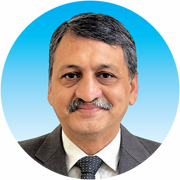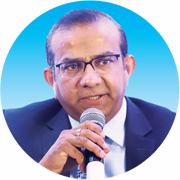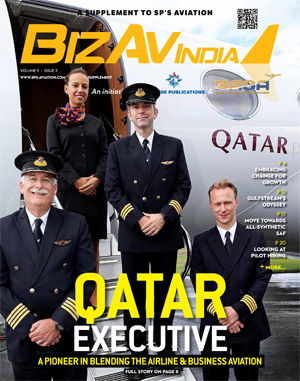Streamlining Growth for Indian GA/BA Industry
The seventh BizAvIndia conference, organised by BAOA, was held in Delhi for the first time

Seventh edition of the BizAvIndia conference was held in Delhi on March 17, 2023. This was the first time the conference was organised in the National Capital. Going forward, the conference would be held every odd year in Delhi and every even year alongside the airshow, Wings India. Being held not on the sides of the airshow but as a standalone event in itself, this BizAvIndia conference spoke volumes of the growth of the Business Aircraft Operators Association (BAOA) as an organisation and its growing strength. The strong presence of stalwarts from the industry both from the operators as well the regulators side also showcased the sincerity and accessibility of the platform that BAOA has managed to create.
“Traditionally, BizAv has been held one day prior to the airshow. However, this year, a conscious decision was made to host the event in Delhi and delink it from the airshow to encourage greater participation. BAOA has been working transparently and democratically for over a decade, thanks to the efforts of our founding President, Rohit Kapur, and our Managing Director, Group Captain Bali. They have established a solid foundation for our organisation, and we are grateful for their contributions,” said Ajay Shah, President BAOA.
The Business Aviation industry has undergone a sea change over the past decade in India and has gained much needed recognition in recent years. The utility of Business Aviation, as a productivity tool and a contributor to economic development, is becoming more evident. The industry has been advocating that this should serve as the prime rationale to put in place an appropriate framework enabling industry’s growth and its role in channelising economic and social benefits throughout India. Some significant changes in terms of perspectives, policies, infrastructure, etc have come about in the industry. However, there is still a long way to go when it comes to certain pain points, finances being a major cause of concern. During the conference, the industry experts gathered to discuss the vision for the industry in the coming decade and touched upon many important issues including financing, infrastructure, leasing, helicopter aviation, GIFT city, regulations, etc.
“THE DEMAND FOR SMALLER AIRCRAFT IS EXPECTED TO GO UP. WITH AN INCREASING NUMBER OF AIRPORTS COMING UP, MORE INTEREST IN THE SECTOR AS WELL AS IN THE COUNTRY ON A GLOBAL LEVEL, MORE ACTIVITY AND MORE DEVELOPMENT FOR THE SECTOR, ALL THESE WILL ENSURE THE INDUSTRY’S GROWTH GOING AHEAD.”
—ASANGBA CHUBA AO, JOINT SECRETARY, MINISTRY OF CIVIL AVIATION
“The goal today is to gain a better understanding of each other’s specific roles in aviation. While our focus is on operating air operations profitably, their (the regulators) focus is on ensuring safety,” said Group Captain Rajesh Bali, Managing Director, BAOA while referring to the presence of the Ministry and the regulatory body, Directorate General of Civil Aviation (DGCA) at the conference. “We need to balance the conversations at these events by understanding each other’s respective jobs and collaborating more effectively with regulators in the future.”
Group Captain Bali also drew attention towards a study conducted by ICAO (International Civil Aviation Organisation) in 2012 that predicted a year-on-year growth rate of 10 per cent for the first 10 years, followed by a growth rate of seven per cent and an additional five per cent in the last five years, resulting in a total of approximately 4,000 small aircraft. However, since then, the number of operators has decreased from 137 to 103, and the number of aircraft has only recently started to increase after a period of decline.
The reasons for this decline might be multiple, but most industry experts underlined that it comes down to the ease of doing business that for now is rough terrain for the General Aviation/Business Aviation (GA/BA) sector in India, specifically because of the financials.
SOME KEY DEVELOPMENTS
While there are certainly gaps that the industry recognises, many also look at this being a good opportunity to tap into. Dr Vandana Agarwal, Ex-Senior Economic Adviser (Additional Secretary), Ministry of Civil Aviation (MoCA) echoed this sentiment as she sees a huge market for growth of the GA/BA industry in India going forward. She called attention to various aspects that the government had looked at including tax framework, management, fragmented ownership in order to reduce cost, in order to ease the burden on all the operators and also to correct some trends that were being seen through Non-Scheduled Operations (NSOP) usage.
“The other area we looked at very strongly was the Maintenance, Repair and Operations (MRO). If you have contracts with foreign MRO vendors in foreign locations and the matter is subcontracted to India, you have zero GST on your MRO services and even if you do direct contracting with India MRO, what used to be 18 per cent, we have brought it down to five per cent,” she said adding that the MRO tax regime is now in place, and it should be effectively implemented.
Infrastructure has been another area of constant concern for the GA/BA industry in India. BAOA has earlier talked about their efforts with the government where they are working on expanding the infrastructure especially FBOs. In a significant step, Delhi got its first exclusive General Aviation terminal in 2020.
Sanjiv Edward, Chief Commercial Officer, Delhi International Airport Limited (DIAL) spoke about the private terminal opened at Delhi. “A dedicated GA terminal was opened at DIAL, India’s first private jet terminal, with a capacity of 150 ATMs/day and 50 pax/hr, catering to Code-C type aircraft. The area covers 4.5 acres adjacent to the existing General Aviation Terminal at Indira Gandhi International Airport, with four parking hangars accommodating aircraft with up to 21.2m wingspan, an apron, fire fighting system, operational offices, and restrooms.” Further the GA terminal’s expansion plans include upcoming covered parking, and a second terminal coming up as a mirror image of the first, along with more hangars. This infrastructure development is expected to attract more business jet operators in India.
“WE ARE COMMITTED TO ADDRESSING THE CONCERNS OF THE INDUSTRY AND ADVOCATING FOR OPTIMAL SOLUTIONS WITH REGULATORY AUTHORITIES.”
—AJAY SHAH, PRESIDENT, BAOA
DIAL is working on the building blocks of the GA hub including a faster turnaround of business planes, dedicated parking slots, an online system for food booking, premium services for passengers, customised requests, and support services for GA aircraft, etc.
The DGCA is also increasingly interacting with the industry to identify initiatives that must be taken. The regulator made some progress in assessing the threshold for smaller aircraft and NSOP and GA aircraft, stated Captain G. Shivkumar, Deputy CFOI, DGCA HQ. “The threshold time has been increased to 90 minutes without additional documentation, which was previously 60 minutes. We have also made changes to the Flight Duty regulations, which have benefited the industry.”
Dr Agarwal highlighted GIFT city that has been a centre of conversation in the industry, since its inception. The GIFT City (Gujarat International Finance Tec-City) is a global financial and technology hub that promises to offer single-window clearances and approvals under one umbrella. The GIFT City initiative is a financial jurisdiction that is entirely different from the rest of India. It offers full currency convertibility, including for the rupee, and about 18 trade entities have registered themselves for rupee trading. Additionally, there are numerous foreign and Indian banks, alternative investment funds, and major insurance companies in GIFT City. There is also a dedicated unified regulator called the IFSC Authority, where five regulators handle the approval process simultaneously including the Reserve Bank of India (RBI), the SEZ (Special Economic Zone) or the International Financial Services Centre (IFSC) regulator. In the first 15 years of establishing your company, you can also choose any block of 10 years to have zero corporate tax. This makes it easy to set up operations, and you can register more than one special purpose vehicle on one address, reducing the cost of manpower.
THE WAY FORWARD
Asangba Chuba Ao, Joint Secretary, MoCA said, “Given the nature of the sector, it is difficult for even good analysts to give an exact prediction right now. However, more people are flying today. These flyers will eventually graduate to upper levels for example the business class people would eventually move to private flying. The upgrade and the rising number of flyers will lead the push. The demand for smaller aircraft is also expected to go up. With an increasing number of airports coming up, more interest in the sector as well as in the country on a global level, more activity and more development for the sector, all these will ensure the industry’s growth going ahead.”
Additionally, ways must be identified to handle the issue of hangarage charges versus housing charges, stated Dr Agarwal. “Looking forward, we must consider the impact of the recent catastrophes and how they have changed the game. The Indian GA industry should focus not only on the domestic market for passengers and cargo but also on cross-trades, such as serving other countries’ needs. I think until you get that under your belt, you will always under perform as far as the vision of India’s GA industry is concerned. To achieve this vision, it’s essential to ensure that financing is green financing. I urge all of you to look into financing your asset acquisition through green financing as much as possible,” she said.
In the tussle between operators and regulators, the conference also touched upon the lack of experts in the regulatory body and the inconsistencies on the part of the regulator as well as the operators. Captain Shivkumar added, “The DGCA lacks expertise, particularly in the area of GA. While our expertise may be limited, we are open to suggestions from the industry and will continue to work towards safer and more efficient aviation operations as we must find a way to meet our requirements without compromising safety. We cannot simply replicate the regulations of other developed nations, as the size and development of our aviation industry is different. It is also important to note that the DGCA is not a training organisation. We are facilitators and not responsible for providing Flight Operations Inspectors (FOIs) or conducting flight checks.” Operators must ensure that they have adequate pilots for their aircraft and that they comply with regulations for training and proficiency checks. “The Civil Aviation Requirement (CAR) mandates that training be conducted once a year for non-scheduled and GA pilots either on the aircraft or in a simulator. Many operators have overlooked this and assumed that a proficiency check is sufficient,” he added.
“A DEDICATED GA TERMINAL WAS OPENED AT DIAL, INDIA’S FIRST PRIVATE JET TERMINAL, WITH A CAPACITY OF 150 ATMS/DAY AND 50 PAX/HR, CATERING TO CODE-C TYPE AIRCRAFT.”
—SANJIV EDWARD, CHIEF COMMERCIAL OFFICER, DIAL
Touching upon funds and finances, Dr Agarwal added that there are now alternative funds that are setting themselves up to deal exclusively with aviation finance. “However, Indian banks are also available, and they are now getting conditioned to look at financing aircraft as assets. Although Indian banks are more comfortable financing larger transactions, we could pursue delegated financing with a share of the asset being mortgaged for smaller aircraft financing. Online financing mechanisms could also be explored for small aircraft financing to gain traction.”
Sunny Guglani, Head of Airbus Helicopters, Airbus India and South Asia & Chairman, FICCI task force on Helicopter and General Aviation shared, “India has not fully tapped the potential of helicopter aviation, which can contribute to nation-building. Airbus is partnering with India to achieve this goal. Airbus has the largest team on the ground in India for helicopters, showing how much it believes in the country.”
“India has great potential for growth. There’s a great chance of synergy too with JSSI. It certainly is one of the strongest markets in the middle run and in the long run,” said Serdar Tamer, Director, Business Development, Jet Support Services, Inc. (JSSI).
Despite the COVID period, there has been a significant spike in movements and activity, with a noticeable increase in the booking of charter flights in India. Sanjiv added, “The Asia Pacific market is experiencing a higher growth rate compared to other regions. India’s GA opportunity is growing, as the country ranks 12th in the list of Ultra High Net Worth Individuals (HNIs), who may drive demand for GA business. India’s G20 Presidency is also an impactful event that will create further momentum that needs to be sustained, leading to a business aircraft market.”
Some of the focus points of GA business in India that came out from the session include:
- Increase leasing facilities in India
- Exploring green financing and delegated financing
- Quick implementation of fractional ownership
- Drive consolidation of industry and services
- Prioritise GA at par with scheduled operators
- Ease of regulatory process for approvals and operating license
- Support infrastructure development like MRO and Hangars
- Tapping into helicopter aviation
- Need for experts in the regulatory body
- Following proper training procedures.








